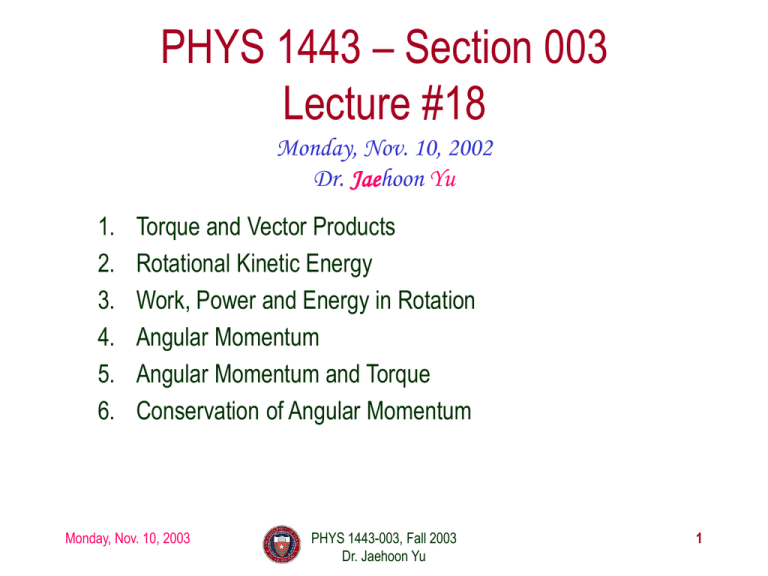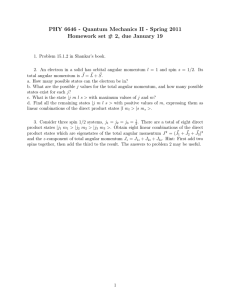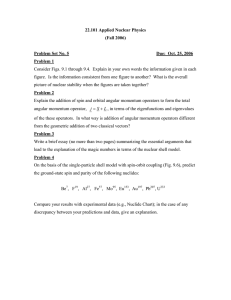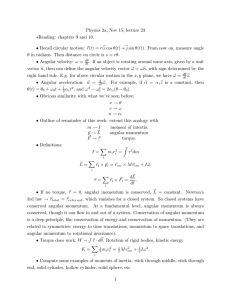Monday, Nov. 10, 2003
advertisement

PHYS 1443 – Section 003 Lecture #18 Monday, Nov. 10, 2002 Dr. Jaehoon Yu 1. 2. 3. 4. 5. 6. Torque and Vector Products Rotational Kinetic Energy Work, Power and Energy in Rotation Angular Momentum Angular Momentum and Torque Conservation of Angular Momentum Monday, Nov. 10, 2003 PHYS 1443-003, Fall 2003 Dr. Jaehoon Yu 1 Announcements • 2nd term exam changes – Problem #7, the correct answer is c, 0.6. • Those who answered b and c get credit – Problem #21, there is no correct answer • All of you received credit for this problem • Class average: 52.1 (term 1: 53) – The two exams are identical in average Monday, Nov. 10, 2003 PHYS 1443-003, Fall 2002 Dr. Jaehoon Yu 2 Torque and Vector Product z O r rxF Let’s consider a disk fixed onto the origin O and the force F exerts on the point p. What happens? p The disk will start rotating counter clockwise about the Z axis y The magnitude of torque given to the disk by the force F is q Fr sin F x But torque is a vector quantity, what is the direction? How is torque expressed mathematically? What is the direction? The direction of the torque follows the right-hand rule!! The above quantity is called Vector product or Cross product What is the result of a vector product? Another vector Monday, Nov. 10, 2003 rF C A B C A B A B sin q What is another vector operation we’ve learned? Scalar product PHYS 1443-003, Fall 2002 Dr. Jaehoon Yu C A B A B cosq Result? A scalar 3 Rotational Kinetic Energy y vi mi ri q O x What do you think the kinetic energy of a rigid object that is undergoing a circular motion is? 1 1 K i mi vi2 mi ri 2 Kinetic energy of a masslet, mi, 2 2 moving at a tangential speed, vi, is Since a rigid body is a collection of masslets, the total kinetic energy of the rigid object is 1 1 2 2 K R Ki mi ri mi ri 2 i 2 i i Since moment of Inertia, I, is defined as I mi ri2 i The above expression is simplified as Monday, Nov. 10, 2003 1 K R I 2 PHYS 1443-003, Fall 2002 Dr. Jaehoon Yu 4 Total Kinetic Energy of a Rolling Body What do you think the total kinetic energy of the rolling cylinder is? P’ CM Since it is a rotational motion about the point P, we can write the total kinetic energy 1 K I P 2 2 2vCM vCM Where, IP, is the moment of inertia about the point P. Using the parallel axis theorem, we can rewrite P 1 1 1 1 2 2 2 2 2 2 K I P I CM MR I CM MR 2 2 2 2 1 1 Since vCM=R, the above 2 2 K I CM MvCM relationship can be rewritten as 2 2 What does this equation mean? Rotational kinetic energy about the CM Total kinetic energy of a rolling motion is the sum of the rotational kinetic energy about the CM Monday, Nov. 10, 2003 PHYS 1443-003, Fall 2002 Dr. Jaehoon Yu Translational Kinetic energy of the CM And the translational kinetic of the CM 5 Kinetic Energy of a Rolling Sphere Let’s consider a sphere with radius R rolling down a hill without slipping. R h q vCM Since vCM=R What is the speed of the CM in terms of known quantities and how do you find this out? 1 1 2 2 2 K I CM MR 2 2 2 1 vCM 1 2 I CM MvCM 2 R 2 1I 2 CM2 M vCM 2 R Since the kinetic energy at the bottom of the hill must be equal to the potential energy at the top of the hill 1 I CM 2 M 2 vCM Mgh K 2 R vCM Monday, Nov. 10, 2003 PHYS 1443-003, Fall 2002 Dr. Jaehoon Yu 2 gh 1 I CM / MR 2 6 Example for Rolling Kinetic Energy For solid sphere as shown in the figure, calculate the linear speed of the CM at the bottom of the hill and the magnitude of linear acceleration of the CM. What must we know first? R h I CM r 2 dm q vCM 2 vCM The linear acceleration of the CM is Monday, Nov. 10, 2003 2 gh 2 1 I CM / MR 10 gx sin q 7 aCM 2 MR 2 5 Thus using the formula in the previous slide vCM Since h=xsinq, one obtains The moment of inertia the sphere with respect to the CM!! 2 gh 1 2 / 5 Using kinematic relationship 2 vCM 5 g sin q 2x 7 PHYS 1443-003, Fall 2002 Dr. Jaehoon Yu 10 gh 7 2 vCM 2aCM x What do you see? Linear acceleration of a sphere does not depend on anything but g and q. 7 Example for Rolling Kinetic Energy For solid sphere as shown in the figure, calculate the linear speed of the CM at the bottom of the hill and the magnitude of linear acceleration of the CM. Solve this problem using Newton’s second law, the dynamic method. What are the forces involved in this motion? Gravitational Force, Frictional Force, Normal Force Newton’s second law applied to the CM gives n f M h Mg F F q x Mg sin q f MaCM y n Mg cosq 0 Since the forces Mg and n go through the CM, their moment arm is 0 and do not contribute to torque, while the static friction f causes torque CM We know that I CM 2 MR 2 5 aCM R Monday, Nov. 10, 2003 We obtain fR I CM 2 MR 2 I CM 2 f aCM MaCM 5 R R R 5 Substituting f in dynamic equations 7 Mg sin q MaCM 5 PHYS 1443-003, Fall 2002 Dr. Jaehoon Yu aCM 5 g sin q 7 8 Work, Power, and Energy in Rotation F dq r O ds Let’s consider a motion of a rigid body with a single external force F exerting on the point P, moving the object by ds. The work done by the force F as the object rotates through the infinitesimal distance ds=rdq is dW F d s F sin rdq What is Fsin? What is the work done by radial component Fcos? Since the magnitude of torque is rFsin, The rate of work, or power becomes The tangential component of force F. Zero, because it is perpendicular to the displacement. dW rF sin dq dq P The rotational work done by an external force equals the change in rotational energy. dW dq dt dt How was the power defined in linear motion? d I I d dq I d I d q dq dt dt dW dq Id The work put in by the external force then 1 1 q W q dq Id I 2f I i2 2 9 2 Monday, Nov. 10, 2003 PHYS 1443-003, Fall 2002 f Dr. Jaehoon Yu f Angular Momentum of a Particle If you grab onto a pole while running, your body will rotate about the pole, gaining angular momentum. We’ve used linear momentum to solve physical problems with linear motions, angular momentum will do the same for rotational motions. Let’s consider a point-like object ( particle) with mass m located at the vector location r and moving with linear velocity v The instantaneous angular momentum L of this particle relative to origin O is L r p 2 2 2 2 What is the unit and dimension of angular momentum? kg m / s [ ML T ] Note that L depends on origin O. Why? Because r changes What else do you learn? The direction of L is +z Since p is mv, the magnitude of L becomes L mvr sin What do you learn from this? Monday, Nov. 10, 2003 If the direction of linear velocity points to the origin of rotation, the particle does not have any angular momentum. If the linear velocity is perpendicular to position vector, the particle moves exactly the same way as a point on a10rim. PHYS 1443-003, Fall 2002 Dr. Jaehoon Yu Angular Momentum and Torque Can you remember how net force exerting on a particle and the change of its linear momentum are related? dp F dt Total external forces exerting on a particle is the same as the change of its linear momentum. The same analogy works in rotational motion between torque and angular momentum. Net torque acting on a particle is F r d p r dt z d r p dr dp dp dL pr 0r L=rxp dt dt dt dt dt O x r y m Why does this work? p Thus the torque-angular momentum relationship Because v is parallel to the linear momentum dL dt The net torque acting on a particle is the same as the time rate change of its angular momentum Monday, Nov. 10, 2003 PHYS 1443-003, Fall 2002 Dr. Jaehoon Yu 11 Angular Momentum of a System of Particles The total angular momentum of a system of particles about some point is the vector sum of the angular momenta of the individual particles L L1 L 2 ...... L n Li Since the individual angular momentum can change, the total angular momentum of the system can change. Both internal and external forces can provide torque to individual particles. However, the internal forces do not generate net torque due to Newton’s third law. Let’s consider a two particle system where the two exert forces on each other. Since these forces are action and reaction forces with directions lie on the line connecting the two particles, the vector sum of the torque from these two becomes 0. Thus the time rate change of the angular momentum of a system of particles is equal to the net external torque acting on the system Monday, Nov. 10, 2003 PHYS 1443-003, Fall 2002 Dr. Jaehoon Yu ext dL dt 12 Example for Angular Momentum A particle of mass m is moving in the xy plane in a circular path of radius r and linear velocity v about the origin O. Find the magnitude and direction of angular momentum with respect to O. Using the definition of angular momentum y v L r p r mv mr v r O x Since both the vectors, r and v, are on x-y plane and using right-hand rule, the direction of the angular momentum vector is +z (coming out of the screen) The magnitude of the angular momentum is L mr v mrv sin mrv sin 90 mrv So the angular momentum vector can be expressed as L mrvk Find the angular momentum in terms of angular velocity . Using the relationship between linear and angular speed 2 2 L mrvk mr k mr I Monday, Nov. 10, 2003 PHYS 1443-003, Fall 2002 Dr. Jaehoon Yu 13 Angular Momentum of a Rotating Rigid Body z Let’s consider a rigid body rotating about a fixed axis Each particle of the object rotates in the xy plane about the zaxis at the same angular speed, L=rxp O y m r x Magnitude of the angular momentum of a particle of mass mi about origin O is miviri 2 Li mi ri vi mi ri p Summing over all particle’s angular momentum about z axis Lz Li mi ri 2 i i Since I is constant for a rigid body Thus the torque-angular momentum relationship becomes What do you see? Lz ext 2 i i i dL z d I dt dt m r I I is angular acceleration dLz I dt Thus the net external torque acting on a rigid body rotating about a fixed axis is equal to the moment of inertia about that axis multiplied by the object’s angular acceleration with respect to that axis. Monday, Nov. 10, 2003 PHYS 1443-003, Fall 2002 Dr. Jaehoon Yu 14 Example for Rigid Body Angular Momentum A rigid rod of mass M and length l pivoted without friction at its center. Two particles of mass m1 and m2 are connected to its ends. The combination rotates in a vertical plane with an angular speed of . Find an expression for the magnitude of the angular momentum. y m2 l q m2 g O m1 m1 g x The moment of inertia of this system is 1 1 1 2 2 I I I Ml m l m2l 2 I rod m1 m2 1 12 4 4 2 l2 1 l 1 M m1 m2 L I M m1 m2 4 3 4 3 Find an expression for the magnitude of the angular acceleration of the system when the rod makes an angle q with the horizon. If m1 = m2, no angular momentum because net torque is 0. If q/p/, at equilibrium so no angular momentum. Monday, Nov. 10, 2003 First compute net external torque m1 g l cosq 2 ext 2 2 m2 g gl cos q m1 m2 2 1 m1 m1 gl cos q 2 Thus ext 2 l 1 I M m1 m2 becomesPHYS 1443-003, Fall 2002 4 3 Dr. Jaehoon Yu l cosq 2 2m1 m1 cos q g /l 1 M m1 m2 3 15 Conservation of Angular Momentum Remember under what condition the linear momentum is conserved? Linear momentum is conserved when the net external force is 0. F 0 dp dt p const By the same token, the angular momentum of a system is constant in both magnitude and direction, if the resultant external torque acting on the system is 0. What does this mean? dL ext 0 dt L const Angular momentum of the system before and after a certain change is the same. Li L f constant Three important conservation laws for isolated system that does not get affected by external forces Monday, Nov. 10, 2003 K i U i K f U f Mechanical Energy Linear Momentum pi p f Angular Momentum Li L f PHYS 1443-003, Fall 2002 Dr. Jaehoon Yu 16 Example for Angular Momentum Conservation A star rotates with a period of 30days about an axis through its center. After the star undergoes a supernova explosion, the stellar core, which had a radius of 1.0x104km, collapses into a neutron start of radius 3.0km. Determine the period of rotation of the neutron star. What is your guess about the answer? Let’s make some assumptions: Using angular momentum conservation The period will be significantly shorter, because its radius got smaller. 1. There is no torque acting on it 2. The shape remains spherical 3. Its mass remains constant Li L f I i I f f The angular speed of the star with the period T is Thus Tf I i mri 2 2p f If mrf2 Ti 2p f Monday, Nov. 10, 2003 r f2 2 r i 2p T 2 3 . 0 6 Ti 2 . 7 10 days 0.23s 30 days 4 1 . 0 10 PHYS 1443-003, Fall 2002 Dr. Jaehoon Yu 17 Similarity Between Linear and Rotational Motions All physical quantities in linear and rotational motions show striking similarity. Quantities Mass Length of motion Speed Acceleration Force Work Power Momentum Kinetic Energy Monday, Nov. 10, 2003 Linear Mass M Distance L Rotational Moment of Inertia I r 2 dm Angle q (Radian) v dr dt dq dt a dv dt d dt Force F ma Work W Fdx xf xi Kinetic Torque Work I W P F v P p mv L I K 1 mv 2 2 PHYS 1443-003, Fall 2002 Dr. Jaehoon Yu Rotational qf q d q i KR 1 I 2 2 18





